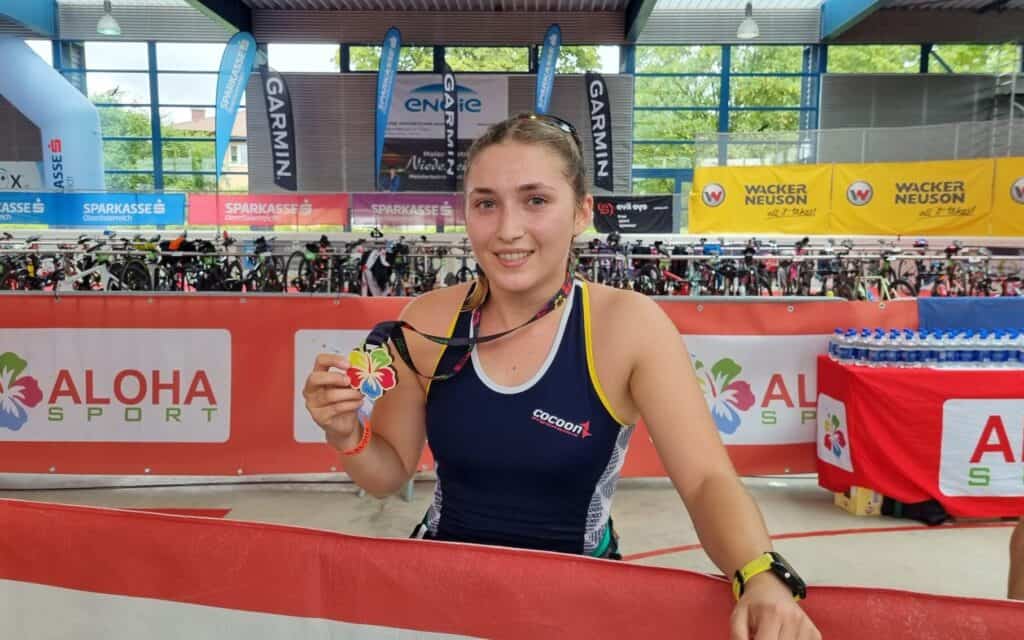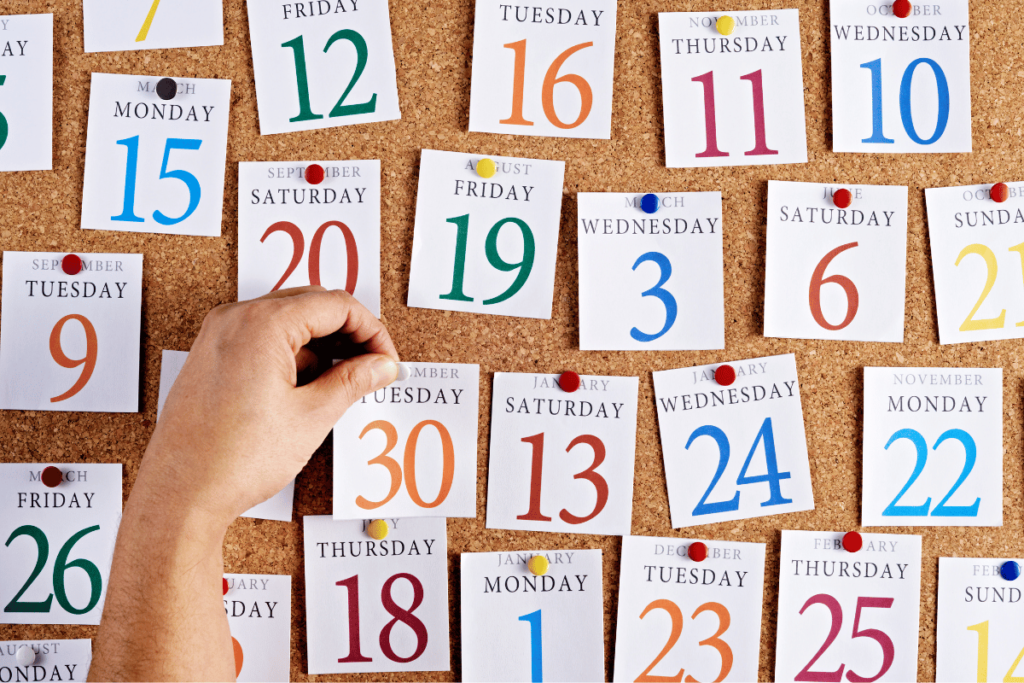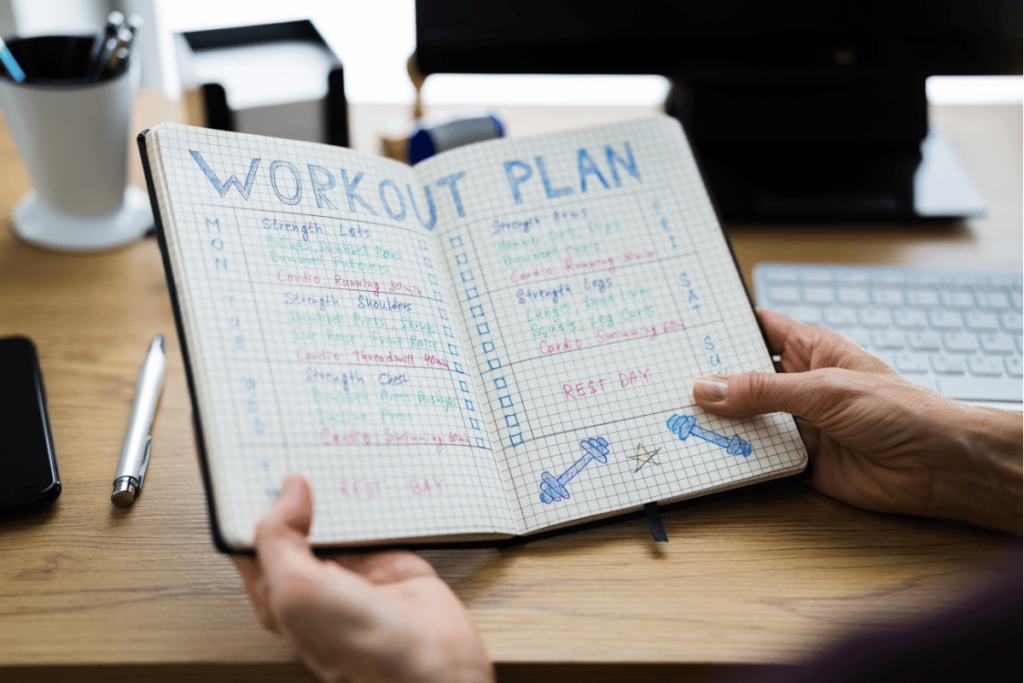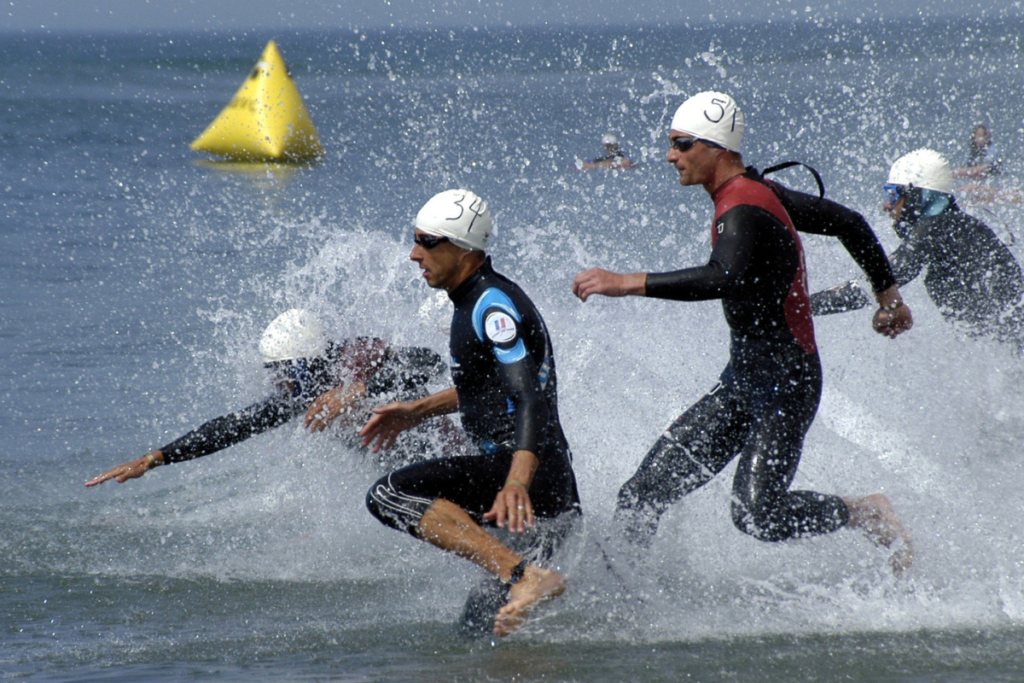The Ultimate Guide: How Long to Train for Triathlon Triumph
Are you considering doing a triathlon but have no idea how long to train for triathlon triumph? Then you’re in the right place.
You can do your first triathlon with as little as 12 weeks of training, but especially for an Iron-distance race it can take up to 30 weeks or longer!
Training for a triathlon will be one of the best decisions of your life!
I did and I’ve literally NEVER felt better (physically and mentally).
Endurance training can be really hard, but honestly, it’s so worth it.
With the help of your triathlon training, you’ll soon feel absolutely unstoppable.
Are you ready to get started? Then let’s get into it!
How Long to Train for Triathlon Triumph?
First, you have to understand, that training for a triathlon takes a heck of a lot of commitment!
It’s definitely no walk in the park.
It takes serious dedication. And the most important thing is consistency.
But when you do, you won’t regret it.
(Maybe at some point during the race, but when you’re crossing the finish line, you’ll be really proud of yourself!
How long to train for a Triathlon?
The minimum time required to complete one of these disciplines varies greatly depending on the distance.
And will be different for everyone.
Everyone has a different starting point.
But these are some general recommendations for beginner triathletes.
How Long Does It Take to Train for a Triathlon Sprint
A sprint triathlon, typically consisting of a 750-meter swim, 20-kilometer bike ride, and 5-kilometer run, is a popular choice for beginners and seasoned athletes alike due to its manageable distances.
Training for a sprint triathlon can take as little as 12 weeks for individuals who are already moderately fit and have some experience with each discipline.
However, beginners may benefit from a slightly longer training period of 16 to 20 weeks to build endurance, improve technique, and ensure a successful race day experience.

How Long Does It Take to Train for an Olympic Triathlon
An Olympic distance triathlon, comprising a 1.5-kilometer swim, 40-kilometer bike ride, and 10-kilometer run, presents a more challenging but attainable goal for many triathletes.
Training for an Olympic triathlon typically requires a longer preparation period of approximately 16 to 20 weeks, especially for beginners who are aiming to build endurance, improve speed, and develop race-specific skills across all three disciplines.
How Long to Prepare for Half Ironman
Training for a half Ironman, also known as a 70.3 triathlon, involves doubling the distances of an Olympic triathlon, with a 1.9-kilometer swim, 90-kilometer bike ride, and 21.1-kilometer run.
Given the increased demands on endurance and stamina, athletes typically need a more extensive training period of approximately 20 to 24 weeks to adequately prepare for the race.
This timeframe allows for focused training blocks, long endurance sessions, and race simulations to build the necessary fitness and mental toughness required to tackle the half Ironman distance.
How Long to Train for First Ironman
Completing an Ironman triathlon, with its grueling distances of a 3.8-kilometer swim, 180-kilometer bike ride, and 42.2-kilometer run, is a big challenge that requires a LOT of preparation and commitment.
For first-time Ironman athletes, it’s recommended to allocate a minimum of 24 to 30 weeks for training, although some may opt for longer preparation periods to ensure adequate readiness for the event.
Essential Training Phases (Periodization)

I’m not a certified triathlon coach (yet). However, all my knowledge stems from my triathlon coaching studies or various literature sources. Like the Triathlon Training Bible from Joe Friel (that I can highly recommend!).
Planning your Training year is very tricky (you might already notice this when you’ve been trying to handle your training yourself for some time).
But generally speaking, the principle of periodization is used.
Periodization is the strategic adjustment of training factors such as workload, sets and repetitions with the aim of optimizing training results while minimizing the risk of overtraining (Source).
This principle divides a training year into individual sections. In triathlon, a training year is (usually) divided into these phases:
Base Training
The foundation of any successful triathlon training plan lies in the base training phase.
This initial period focuses on building endurance and strength across all three disciplines: swimming, cycling, and running.
During this phase, the emphasis is on consistency and gradually increasing training volume while maintaining lower-intensity workouts.
Base training lays the groundwork for the entire season, establishing a solid aerobic base that will support more intense training later on. Workouts during this phase may include long, steady swims, rides, and runs, aimed at developing cardiovascular endurance and muscular endurance.
The goal is to build resilience and prepare the body for the increased demands of the upcoming race season.
Build Phase
As the base training phase progresses, athletes transition into the build phase.
This phase is characterized by an increase in training intensity, with a focus on more specific workouts aimed at improving speed, power, and race-specific skills. Workouts become more structured and targeted, incorporating intervals, tempo efforts, and race simulations.
In the build phase, athletes continue to build upon the endurance foundation established during base training while introducing higher-intensity efforts to improve performance.
Swim sessions may include speed work and technique drills, bike rides may incorporate hill repeats and threshold efforts, and runs may focus on speed and race pace training.
The goal of the build phase is to continue building fitness while honing race-specific skills and preparing the body for peak performance.
Peak Phase
The peak phase represents the culmination of the training cycle, leading up to the main event.
During this phase, the focus shifts to fine-tuning fitness and ensuring peak performance on race day. Workouts become more race-specific and intense, with an emphasis on simulating race conditions and fine-tuning race strategies.
In the peak phase, athletes may incorporate high-intensity interval training (HIIT), race pace efforts, and brick workouts to simulate the demands of race day. Swim sessions may focus on speed and race-specific skills, bike rides may include time trials and race simulations, and runs may incorporate tapering runs and race pace efforts.
The goal of the peak phase is to sharpen fitness, optimize race readiness, and ensure that athletes are prepared to perform at their best on race day.
Tapering Before the Race
The final weeks before the race are devoted to tapering, a period of reduced training volume and increased rest to allow the body to fully recover and optimize energy reserves for race day.
Tapering involves gradually decreasing training volume while maintaining intensity, allowing athletes to peak at the right time and perform at their best on race day.
During the tapering phase, athletes may reduce the duration and frequency of workouts while maintaining the intensity of key sessions.
Swim, bike, and run workouts may be shorter and less frequent, with an emphasis on maintaining race pace and sharpening skills. Rest and recovery become priorities, allowing the body to repair and adapt to the demands of training while minimizing the risk of injury and fatigue.
Tapering is a critical phase of the training cycle, allowing athletes to arrive at the starting line feeling fresh, rested, and ready to perform.
By carefully managing training volume and intensity during the tapering phase, athletes can optimize their performance and maximize their chances of success on race day!
Creating Your Training Plan

Annual Training Plan
Let’s work on your own triathlon training plan with what we’ve learned so far.
But where to start.
First, you have to note this:
Your training schedule has to be dynamic. During the training year, unexpected things such as illness or other commitments in your daily life come up from time to time. And that’s ok! This also means, resting when you need it.
This is a rough overview of how to create an annual training plan:
- First, you have to define goals for your season. This is a very important step as it forms the backbone of your training plan. I wrote a few paragraphs on goal setting in this post about mistakes to avoid while training for your first triathlon. Check it out and form your goals with the framework mentioned there.
- Then, identify your weaknesses and set some training objectives to minimize these weak spots.
- Define your annual training scope, this depends on your goals and the duration of your race.
- Set priorities for competitions, typically you give each race a score from A to C with A being the highest priority.
- Then divide the weeks into the previously described training phases and find out your weekly training volume.
Of course, many more factors go into the planning of your training. But this is a broad overview.
Weekly Training
A typical training week will cover each discipline at least once (depending on your goal distance).
And according to your annual plan, you can then plan your training weeks.
It’s a little bit more complex than that, but basically, that’s it.
If you feel overwhelmed with planning your training, I highly recommend that you seek out a coach.
That way you don’t have to worry about it again every week and only have to complete your training sessions.
Unspoken Rules of Triathlon Training
I think you will probably encounter these things/moments in your journey:)
- You will never like all three disciplines at once. But it always rotates through.
- Triathlon will become your identity. Because you’ll spend a LOT of time training.
- You’ll talk about it constantly…
- People will ask you about your race distance regularly.
- Eating ungodly amounts of carbs😂. And basically being able to eat what you want (but hopefully healthy and nutritious…)
Don’t forget this in Your Training!

Consistency is Key
Consistency is the cornerstone of progress in any training program!!!
Stick to your planned workouts as much as possible, even when you’re not feeling particularly motivated or life gets busy.
Consistent training builds fitness steadily over time and lays the foundation for success in your racing!
Listen to Your Body
Pay attention to signals from your body during training.
If you’re feeling excessively fatigued, sore, or experiencing pain, it may be a sign that you need to dial back the intensity or volume of your workouts.
Rest when needed and don’t push through pain that could lead to injury!!!!! (I’m serious…)
Prioritize Recovery
Recovery is just as important as training itself.
Incorporate rest days, active recovery sessions, and recovery strategies such as foam rolling, stretching, and massage into your routine. Adequate sleep, hydration, and nutrition are also crucial for supporting recovery and optimizing performance.
Check out my FREE Recovery Guide where you’ll learn everything you have to know to recover better (and faster too!).
Get the ONE Triathlon Training Recovery Guide Endurance Athletes Need!

Set Realistic Expectations
Be realistic about your goals and expectations.
Progress takes time!
And improvements may not happen overnight.
Set achievable short-term and long-term goals that challenge you without overwhelming you. Celebrate small victories along the way and trust in the process of gradual improvement.
Focus on Quality over Quantity
Quality workouts trump quantity when it comes to training effectiveness.
Prioritize the quality of your workouts over simply logging miles or hours…
Focus on executing each session with intention and purpose, whether it’s nailing your pacing in the long run or maintaining proper form during strength training.
Incorporate Cross-Training
Don’t neglect cross-training activities that complement your triathlon training.
Activities such as yoga, Pilates, swimming, and cycling can improve flexibility, strength, and mobility, while also providing a mental break from triathlon training.
Stay Hydrated and Fuel Properly
Proper hydration and nutrition are essential for sustaining energy levels, supporting recovery, and optimizing performance.
Stay hydrated throughout the day, especially during workouts. Take a reusable water bottle with you everywhere you go.
Fuel your body with a balanced diet rich in carbohydrates, protein, healthy fats, vitamins, and minerals.
Little healthy snacks throughout the day make this much easier for me! For example taking some blueberries or some nuts with you as a snack to work, school whatever.
Embrace Rest Days
Rest days are not a sign of weakness but an essential component of any training plan.
Use rest days to recharge both physically and mentally! Allow your body to recover and adapt to the stress of training.
There’s stress from training and stress from our everyday lives.
If we have more of either, we need to incorporate more rest! (This is also part of the adaptability that I mentioned before already)
Avoid the temptation to fill rest days with intense activities and instead prioritize relaxation and rejuvenation (for real!).
Stay Mentally Strong
Triathlon training is as much a mental challenge as it is a physical one.
Stay mentally strong by cultivating a positive mindset, setting realistic goals, visualizing success, and practicing mental skills such as focus, resilience, and self-confidence.
Remember why you started and draw motivation from your passion for the sport.
Or, remember where you want to go…this is what I’m trying right now.
But I’m really a big fan of mental training and I can highly recommend it!
Enjoy the Journey
Above all, remember to enjoy the journey of triathlon training.
I know sometimes it feels like time has stopped, but believe me, enjoy the time.
The journey is the destination. And your training is the real triathlon, not the race itself. (This sounds better with Ironman haha).
Also, embrace the highs and lows, the challenges and triumphs, and the growth and self-discovery that come with pursuing your athletic goals.
Find joy in the process of becoming the best version of yourself as an athlete, and celebrate every step of the way!
Wrapping Up
Training for a triathlon is an intense but rewarding journey.
With the right plan, attitude, and discipline, you can achieve incredible things.
Remember, it’s not just about the finish line; it’s about the experiences, the community, and the personal growth you will gain along the way.
I’m really excited for you to start this journey. I would be thrilled to hear your triathlon story! Write me a DM on Instagram (paula_sierzega), I would love to connect🫶!
Frequently Asked Questions
What is a respectable triathlon time?
The definition of a “respectable” triathlon time can vary widely depending on factors such as the distance of the race, the athlete’s age and gender, and the specific course conditions. However, as a general guideline:
- For a sprint triathlon (typically consisting of a 750m swim, 20km bike, and 5km run), a respectable time for an age-group athlete might range from around 1 hour to 1 hour and 30 minutes, depending on factors such as age, experience, and course difficulty.
- For an Olympic distance triathlon (1.5km swim, 40km bike, 10km run), a respectable time might range from around 2 hours to 2 hours and 30 minutes for age-group athletes.
- For longer distances such as a half Ironman (70.3) or Ironman (140.6), respectable times can vary significantly based on individual factors, but completing the race within the cutoff times established by the event organizers is generally considered an achievement in itself.
Ultimately, what constitutes a “respectable” time is subjective and may vary depending on individual goals and expectations. The most important thing is for each athlete to set realistic goals based on their own abilities and strive to achieve their personal best. This article about how long a triathlon takes answers this question in more detail.
How many hours a day do professional triathletes train?
Professional triathletes typically devote a significant amount of time to training each day, as this sport demands a high level of dedication and commitment. On average, professional triathletes may train anywhere from 4 to 6 hours per day during peak training periods leading up to key races.
How many days a week should a triathlete strength train?
Many triathletes are not particularly fond of strength training. But the positive aspects are undeniable. You’ll get faster and more efficient and are less likely to get injured. I would recommend at least one strength session per week. In the build phase maybe even 2-3.
